We have breakfast under overcast skies that soon degrade into a steady drizzle. We are holding our breath that things will clear off since we head out for a cruise on Doubtful Sound at 1:30PM. We hang out in the campers’ lounge to charge electronics and spend some time catching up the blog. We get a great surprise, a video call from Mike and Willa!
By noon we see patches of blue sky and a very warm sun is peeking through. Yeah! We pack lunch and after a short walk to the dock are anxiously waiting to board for the first of three boat rides today. There is no road access from this side of the lake to Doubtful Sound. Our trip entails a boat shuttle across the lake, a bus ride over Wilmot Pass then the actual boat tour of the Sound. Then we retrace our steps across the pass and lake Manapouri. It is a bit convoluted but each leg is cool in its own way.
We don’t have rain but we do have wind. Our various captains talk of 40 km/hr head winds as we sail west. There is pretty heavy chop on the open water of Lake Manaporu. Of course, we have to ride on the open deck. When combined with our forward speed the wind practically blows us over. It is about an hour ride but the view is great and we get a little lesson on hydropower production in the area. The bus ride is ok too. Early morning rain has brought to life many waterfalls along the route and it is a chance to get a close up look at the vegetation on these rainy, rainy mountainsides. They get 8 to 10 meters of rain a year on the west flanks of this range. With that much water there is moss on everything and trees grow on rock faces with virtually no topsoil. It is soooo green.
Doubtful Sound, 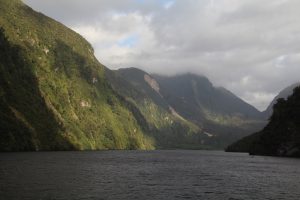 it is impossible to grasp the scale of this place. Water to a depth of 430 meters filling a broad U-shaped valley 2 km wide in places. The main channel is joined by 5 arms each carved by adjoining glaciers. We motor our way out toward sea buffeted by winds and bounced on chop sometimes rolled on up to 8-foot swells. It is like a cork bobbing in a bath tub. Shear rock walls rise almost vertically on either side. Trees blanket surfaces where it seems impossible that they could find purchase. Moss blankets pretty much every surface. Streaks of grey-brown slice the lush growth where tree slides have scrubbed the landscape back to bare stone. Waterfalls cascade everywhere sometimes flooding across the cliff faces and others freefalling from a precipice. Wind pushes the spray in huge arcs. Awesome.
it is impossible to grasp the scale of this place. Water to a depth of 430 meters filling a broad U-shaped valley 2 km wide in places. The main channel is joined by 5 arms each carved by adjoining glaciers. We motor our way out toward sea buffeted by winds and bounced on chop sometimes rolled on up to 8-foot swells. It is like a cork bobbing in a bath tub. Shear rock walls rise almost vertically on either side. Trees blanket surfaces where it seems impossible that they could find purchase. Moss blankets pretty much every surface. Streaks of grey-brown slice the lush growth where tree slides have scrubbed the landscape back to bare stone. Waterfalls cascade everywhere sometimes flooding across the cliff faces and others freefalling from a precipice. Wind pushes the spray in huge arcs. Awesome.
Wind and rough water make wildlife sightings difficult. We do get a couple great looks at the resident pod of bottlenose dolphin as the play about our wake. A colony of eared seals breed at the entrance of the Sound. They are basking in the sun and the pups romping about. A couple Albatross check out or wake. There are gulls of course. Not a bad showing overall.
It has been a beautiful day and a great expedition. I highly recommend it.
Author Archives: Lynn
Turning North
In just a few miles the jagged peaks of the Southern Alps appear as a backdrop to the rolling green hills we have seen the past few days. We are entering the country of vast mountain lakes, Hauroko, Monowai, Manapouri (our destination for today), and Te Anau and rivers that direct the huge mountain rains out to sea. Most if not all have been harnessed to some degree for power generation but still seem wonderfully wild.
Like our redwoods, NZ has a gigantic native tree, the Totara. They are fighting to protect the few remaining stands of virgin timber that contain them. We have to check out the reserve and big Totora Walk so Kent takes on an 18 km narrow and getting narrower gravel road that includes a wait for cattle to cross and a bunch of one lane bridges. Much like the redwoods, the giant trees are awesome and one has to be grateful that somebody had the fore-thought to protect at least some of them.
We come across a manmade wonder, the Clifden suspension bridge. The span was built 1899 and still stands. It carries foot and bicycle traffic now instead of heavy loads of livestock, lumber, and wool but still impressive.
Home sweet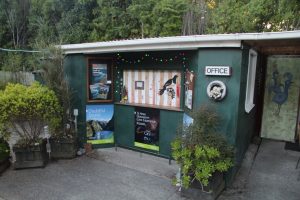 home for the night The Possum Lodge. Eclectic and friendly. Gotta love it.
home for the night The Possum Lodge. Eclectic and friendly. Gotta love it.
The Coast to the Mountains
We start with beachside breakfast 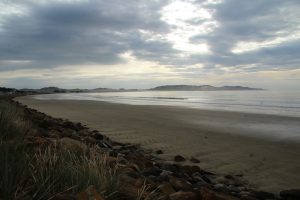 along Colac Bay; coffee and blueberry-white chocolate scones. It is yummy but anything tastes good with a view like this. For those considering passing through here, the freedom camping here by the boat ramp looks pretty nice. You’ll likely have a bit of company but its level, has a nice restroom, and a great ocean view. That’s at least two attributes better than the Tavern Holiday park!
along Colac Bay; coffee and blueberry-white chocolate scones. It is yummy but anything tastes good with a view like this. For those considering passing through here, the freedom camping here by the boat ramp looks pretty nice. You’ll likely have a bit of company but its level, has a nice restroom, and a great ocean view. That’s at least two attributes better than the Tavern Holiday park!
It is low tide so we check out Monkey Island. A giant bolder sits some 100 meters out the beach. Since the tide is out we stroll the soft sand – bare feet would feel nice – then clamber across smaller boulders – boots were a good choice – to reach narrow concrete steps that take us to a platform atop the boulder, Monkey Island. Another spectacular view is made perfect as the only sounds to be heard are the crash of waves and the call of oyster catchers. Shell fish hunting looks to be pretty good and it is fun to watch how the birds work their way into each of the different types of mollasks.
Our last look seaward, at least for now, is at McCracken Rest. The waves break across a number of tiny islands that Maori legend claims are the broken teeth of a giant whale that chewed the strait between mainland and Steward island. Scientist explanation is once again less colorful, the islands are erosion resistant remnants of a long-ago volcanic rim.
The last stretch of coast
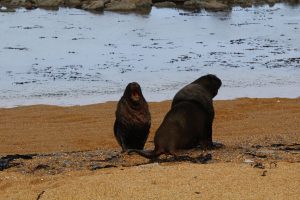 At Waipapa Point we find a half dozen seals sunning and bathing in the sand. Mostly they look like brown rocks. There is an occasional burst of energy in the name of territorial disputes. It requires some patience but they are fun to watch. We check out “The end of the Road” in Bluff just south of Invercargill then make our way to The Tavern and Holiday Park in Colac Bay for night six. About what you would expect….
At Waipapa Point we find a half dozen seals sunning and bathing in the sand. Mostly they look like brown rocks. There is an occasional burst of energy in the name of territorial disputes. It requires some patience but they are fun to watch. We check out “The end of the Road” in Bluff just south of Invercargill then make our way to The Tavern and Holiday Park in Colac Bay for night six. About what you would expect….
On across the coastal drive
It is a perfect morning, bright and sunny with a cool breeze. Birds are singing all around us. 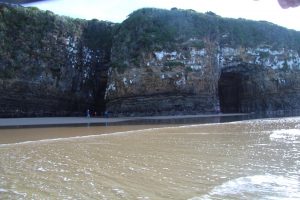 We are off to explore. First stop, Cathedral caves. The caves are only accessible during low tide so off we go, on the trail by 9:30. Down and down we go winding our way through lush dense forest the air filled with the smell of wet earth occasionally brightened by some sweet-smelling flower. IT is tropical-like and beautiful. Final switchbacks bring us to brilliant sun dancing on rolling waves on a broad beautiful beach. No signs but telltale footprints lead us to the cliffs just down the beach. 10,000s of years of wave action found a weakness at fractures and has carved through rock formed over 100 million years ago. The result is two tunnels of about 100 meters each angled toward each other and ultimately joined deep in the cliff. Nature is pretty darned impressive.
We are off to explore. First stop, Cathedral caves. The caves are only accessible during low tide so off we go, on the trail by 9:30. Down and down we go winding our way through lush dense forest the air filled with the smell of wet earth occasionally brightened by some sweet-smelling flower. IT is tropical-like and beautiful. Final switchbacks bring us to brilliant sun dancing on rolling waves on a broad beautiful beach. No signs but telltale footprints lead us to the cliffs just down the beach. 10,000s of years of wave action found a weakness at fractures and has carved through rock formed over 100 million years ago. The result is two tunnels of about 100 meters each angled toward each other and ultimately joined deep in the cliff. Nature is pretty darned impressive.
More great works of nature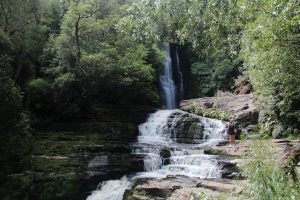 , waterfalls. It rains a lot here and we check out waterfalls both great and small. Some impressive…some redunculous… Little Niagara. Some explorer guy had seen the US/Canadian Niagara and dubbed this little rock overflow as its namesake. Its real fame here, it is a prime spot for whitebait..flashback, they are not for me!
, waterfalls. It rains a lot here and we check out waterfalls both great and small. Some impressive…some redunculous… Little Niagara. Some explorer guy had seen the US/Canadian Niagara and dubbed this little rock overflow as its namesake. Its real fame here, it is a prime spot for whitebait..flashback, they are not for me!
Lake Wilkie is dark reflective pool ringed by dense forest. It is a quiet spot amid virgin timber, magnificent old growth trees. They are mostly different species than at home but just as wonderous to see. Bird song fills the mature forest and these unfamiliar fellows seem even illusive in the dense growth as the ones at home.
The southernmost point on the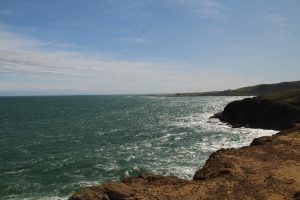 NZ mainland, Slope point. It is a short walk across rolling sheep meadow to a simple sign but oh, the view! Rugged ocean cliffs and the roaring crashing sea are mesmerizing. A view of seemingly endless Southern Ocean is interrupted only by faint outlines through the mist of the mountains on Steward Island.
NZ mainland, Slope point. It is a short walk across rolling sheep meadow to a simple sign but oh, the view! Rugged ocean cliffs and the roaring crashing sea are mesmerizing. A view of seemingly endless Southern Ocean is interrupted only by faint outlines through the mist of the mountains on Steward Island.
It’s been a full day. We head for Curio Bay campground and settle into an ocean front site with the wave s crashing just below us. I can feel the pounding! Right here in camp we have our very own yellow penguin colony. Well, it’s just two nesting pairs but still – there are only 300 nesting pairs on the entire mainland so 2 is good. Sadly, they are not real successful here. Only one of four that hatched has made it so far and it is about to fledge. He/She came out to show off today. I still think it is so weird to see them waddling in and out of the shrubs..penguins belong on ice or in the water, right? Well not all penguins and not all the time. Mom didn’t show up before the sand flies and chill evening air ran us in. Glad to see the little fellow though.
s crashing just below us. I can feel the pounding! Right here in camp we have our very own yellow penguin colony. Well, it’s just two nesting pairs but still – there are only 300 nesting pairs on the entire mainland so 2 is good. Sadly, they are not real successful here. Only one of four that hatched has made it so far and it is about to fledge. He/She came out to show off today. I still think it is so weird to see them waddling in and out of the shrubs..penguins belong on ice or in the water, right? Well not all penguins and not all the time. Mom didn’t show up before the sand flies and chill evening air ran us in. Glad to see the little fellow though.
At low tide a petrified forest appears. It formed millions of years ago when floods carried ash from volcanoes and buried the entire forest as it stood. Truthfully, this is one of those “trust me” things. They don’t really look like trees to me.
We end our day gazing out over our private little section of the southern sea, sipping tea paired with Tim Tams. Good night.
Coastal Catlins
We drop onto the coastal loop of the southern scenic route. The ever present rolling green hills stretch out before us then are abruptly replaced by a dramatic rugged coast. All along there are opportunities to stop and admire the rugged land. Kaka Point is rugged and wild. Nugget Point lighthouse is stark white against the blues sky and ocean. Surfers swarm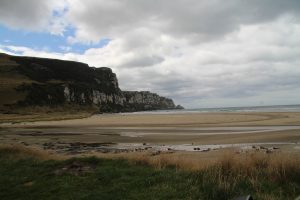 the beach at Purakounui Bay. It is tempting to stay and watch but its only 1PM so we better move on a bit further. Waterfall trails call our names so we check out Purakaunui and Matai before settling in at the Dept of Conservation campground at Papatowai, our home for night five. They are pretty informal with these campgrounds. It is just a self-pay station at a big grassy area and you find a spot that suits. They do have a tenters’ kitchen and passable restrooms – nonpotable water though. Birds are all around us, especially the noisy native Tui. It took us an hour to get a picture of the silly fellow. A quick walk out to the estuary beach and we have our first encounter with the infamous sand flies. Ooh, they are as mean as reviews say they are.
the beach at Purakounui Bay. It is tempting to stay and watch but its only 1PM so we better move on a bit further. Waterfall trails call our names so we check out Purakaunui and Matai before settling in at the Dept of Conservation campground at Papatowai, our home for night five. They are pretty informal with these campgrounds. It is just a self-pay station at a big grassy area and you find a spot that suits. They do have a tenters’ kitchen and passable restrooms – nonpotable water though. Birds are all around us, especially the noisy native Tui. It took us an hour to get a picture of the silly fellow. A quick walk out to the estuary beach and we have our first encounter with the infamous sand flies. Ooh, they are as mean as reviews say they are.
Into the Catlins
We are heading south from Dunedin. Rolling hills painted all hues of green stretch out as far as we can see. Sheep are everywhere. Big ones and small ones shorn and in full fluffy wool coats.
Night four we spend in a friendly family run park in Balclutha. The hosts are great and very helpful and all the shared space is wonderful. Kent grills burgers on their six-burner gas grill and doing dishes in a full kitchen is a great change. That pack folks in pretty tight but the vibe is good. It is a comfy place for the night.
The Royal Albatross Center
Taiaroa Head near Dunedin NZ is one of just two nesting sites and the only one on mainland for the Northern Royal Albatross. This colony includes sixty some pair, half of which nest any given year. Five nests are visible from the viewing blind. We get a peek at one of the chicks. Non-breeding teenagers are enjoying the strong winds as they soar around us to within 30 feet (we are behind tinted glass). They are magnificent with their stark white/black coloring and 9 foot wingspan. This bird spends 80% of its life at sea. It is remarkable to see them so close.
We get a peek at one of the chicks. Non-breeding teenagers are enjoying the strong winds as they soar around us to within 30 feet (we are behind tinted glass). They are magnificent with their stark white/black coloring and 9 foot wingspan. This bird spends 80% of its life at sea. It is remarkable to see them so close.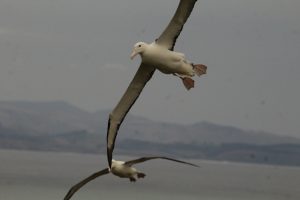 We spot a number of other birds new to us. Check in later for identification, maybe.
We spot a number of other birds new to us. Check in later for identification, maybe.
Portabella Road out to the center hugs the bays then climbs steeply to the headlands. Great views for the rider, a bit white knuckle for the driver who is still concentrating more than usual just to stay on the correct side of the road!
Night three our home is the Dunedin Holiday Park; a collection of theme decorated mini cabins and patches of soft green grass for tenters and we non-powered campervan folks. It is rainy but the trusty back hatch provides plenty of shelter for fixing supper. We have a cozy quiet night.
Moeraki Boulders
 The geological story is cool, sediment accumulated over thousands of years and solidified into these nearly perfect spheres that were buried by retreating seas and later exposed by those same waters. Native legend tells of canoes lost at sea and these boulders are their cargo of gourds that was scattered to the beaches. Impressive to see no matter the origin story one chooses. I say at least one of them looks like a pint-sized Death Star! Some like eggs that have broken with the yolks frozen in time as they pour out of the shell.
The geological story is cool, sediment accumulated over thousands of years and solidified into these nearly perfect spheres that were buried by retreating seas and later exposed by those same waters. Native legend tells of canoes lost at sea and these boulders are their cargo of gourds that was scattered to the beaches. Impressive to see no matter the origin story one chooses. I say at least one of them looks like a pint-sized Death Star! Some like eggs that have broken with the yolks frozen in time as they pour out of the shell.
Oamaru
We stroll the streets and wharf. Oamaru is a Victorian era deep water shipping port. The waterfront streets still lined with grand limestone warehouses that now house all manner of shop and studio. In contrast, a splash of steam punk contributes bizarre and grand steel sculptures and kinetic art. There is a steam punk museum – from the outside I’d say a good stop if you have the time. Work-weary fishing boats are moored along the wharf. It is home to the Whitestone cheese factory. I couldn’t pass up their Vintage Blue Cheese, second in the world in 2019. Stinky but absolutely delicious.
I get a little too brave ordering lunch!
We are on the hunt for fish ‘n chips since we are in a fishing town and end up at The Star and Garter a small local place with a friendly vibe which does indeed have fish and chips on the menu. Kent goes for the Blue Cod and I can’t pass up the chalkboard special I see in the window, whitebait fritters.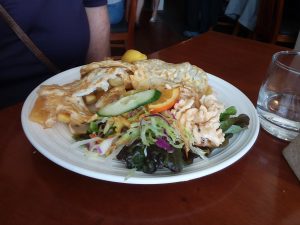 Well let me just say, it is what it sounds like. Little tiny whole fish stirred into a light eggy batter and fried. Edible but not something I would do again. The pumpkin soup I had for a starter was fantastic.
Well let me just say, it is what it sounds like. Little tiny whole fish stirred into a light eggy batter and fried. Edible but not something I would do again. The pumpkin soup I had for a starter was fantastic.
